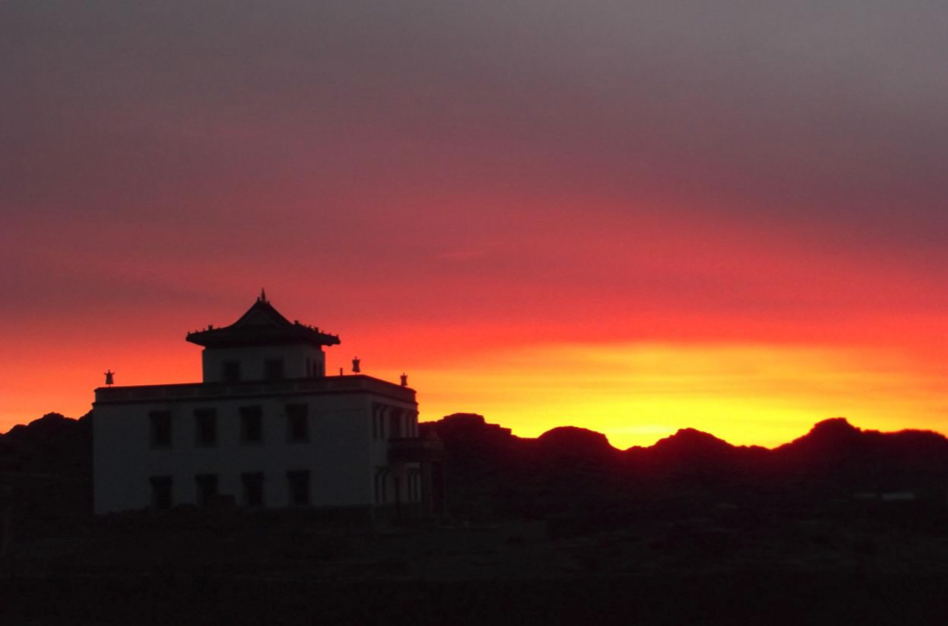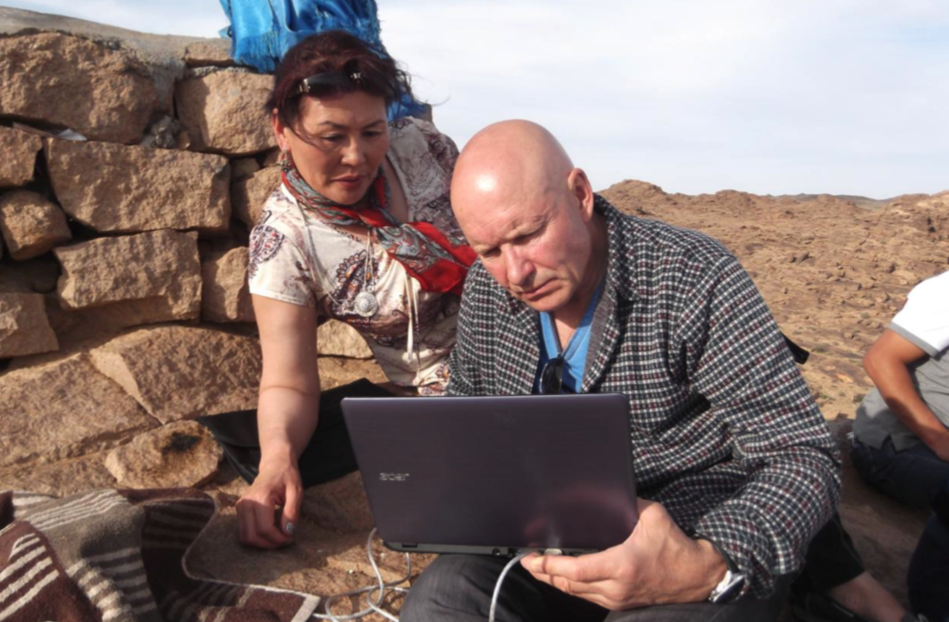Mongolian impressions
byKorotkov Konstantin
I woke up at half past five in the morning, went out, and immediately went back to getmy camera – the entire band rocks on the horizon blazed by the rising sun. Against this background, white building of a monastery shone brightly standing out among the surrounding rocks. This impression was like the last, the final chord in our journey. For several days we traveled about on the spaces of the Gobi desert in southern Mongolia. We had a special task: in a few days to visit several places of natural phenomena, revered by local residents, and to measure with the sensor “GDV Sputnik“.

The main character in Mongolia – Genghis Khan. 50 km from Ulan Bator is built his huge statue of 40 meters height, and in every town you can see a monument to ancient Mongolia warrior on horseback. A little nation–there are now living in Mongolia for about 3 million people, half of them in Ulan Bator, so that in the XIII century they were clearly much less – captured and destroyed the flourishing civilizations and for 200 years became the ruler of half the world. Mongols Empire then broke up, and the civilized world could lick the wounds and continue the historical development. But the spirit of Genghis retained by the people. For a mongol 500 km –is not the distance, and 100 km –is not a hook. There favorite food –is lamb stew, drink – Genghis Khan vodka. But there are a lot of interesting moments in Mongolia.
The Mongols – are very friendly, hospitable and cheerful people, they always joking and laughing. Someone speaks English only in the capital, in some places you can meet people who studied in Russia and good speaking in Russian. So go on a journey in Mongolia without a Mongolian companion –is a risky activity. However, on the way back on the plane, I met a gentleman from Denmark, who single-handedly rode a bicycle for 2,000 kilometers through the deserts of Mongolia and somehow was able to communicate on the way. But for this you have to be very-very enthusiastic.
In no other country in the world have I seen such an attitude toward healing and bioenergy. I was invited to Mongolia Bioenergy Center, led by Dr. Sarandavaa. We met in Kuala Lumpur, at a conference at Taylor University, where the professor Jerald Pollack and myself talked about the latest scientific discoveries. A month later I was in Ulan Bator, where Dr. Sarandavaa organized a conference for 700 people and a day seminar with hundreds of participants.
Bioenergy Center – is a separate five-story building filled with wonderful different things. In each room –there are numerous statues and statuettes of Buddhist saints, and on the top floor is sanctuary with a large statue of Buddha surrounded by monsters taller than a man in a scary masks and colorful robes. At another two floors there are rooms with modern equipment for electromagnetic therapy, massage, music therapy. Hundreds of patients were treated at the center for 15 years, they were travelling to the active sites with Dr. Sarandavaa where they practiced meditation and received the required advices. We watched a presentation on the activities of the Centre, where impressive results of helping people to get rid from the worst diseases were shown. All these results are closely monitored every year. Unfortunately, Dr. Sarandavaa speaks only in Mongolian, and it was difficult for us to discuss the finer points of her treatment.
Another interesting place, where I was invited – is The National Institute for Scientific Research and Treatment of Bioenergy – is a 9-storey building, with the owners with whom we had known each other for several years. For two consecutive years they were coming to St. Petersburg for our congresses, they began to use actively the GDV method and presented at the Congress results of bioenergetic treatment of a large group of patients. Professor Baysuri led the research, and as a healer was a sweet woman named Parasuram. We were introduced to the laboratory, where the use GDV devices and other equipment, and then we went into the hall, where 200 people were expected for Parasuram appearance. This is happening every day, 5 days a week – people are coming by the morning and evening sessions on bioenergy, and in a couple of months a lot of them getting rid of a variety of diseases. Naturally, many people continue to visit. The scientific group collects statistics, conducts measurements of patients before and after treatment, and we agreed that for the next, the twentieth congress in St. Petersburg, they would present a detailed report on their findings.
So in Mongolia we have the unique situation – bioenergetic treatment is officially recognized, its effects are studied, this direction is supported by the Academy of Sciences of Mongolia. We met with the President of the ASM professor B. Enkhtuvshin, and he said that they are interested in bioenergy research and ready to provide full support. Conducting mass sessions for many years – it is a unique phenomenon, and nowhere in the world except in Mongolia, no systematic studies of this phenomenon was being done. We must try to make their results known to the world and to scientific community.
Ulan Bator lies in a valley between the hills, small huts sprawled on the slopes, modern buildings coexist with wooden huts, the streets were not designed for current number of vehicles, of which almost half are jeeps. Therefore, in Ulan Bator there are always roads jam, and to come from one part of the city to the other takes at least an hour. Public transport is virtually nonexistent.
After meetings and workshops, we went on a trip to the South Gobi desert, organized by the Center of Dr. Sarandavaa. The caravan of three SUVs quickly rolled on the highway, which, however, was soon be over and we drove straight through the desert. That’s why there is best to have a jeep. Outside the window – the lifeless rocky planes, with a few yurts, flocks of sheep and goats, accompanied by the Mongols on acamel. All as it was a 1,000 years ago. XXI century – a century of contrasts: riding a camel Mongolian talking on a cell phone with a relative who is going to come on a visit in his Lexus. Periodically in the desert strong winds begin – and we were just got in this period. Bitter cold in winter, hot in summer, bumps, rocks, sand, and occasionally group of mangy camels, either wild, or left free to breed.
Mongolian impressions In 4 days we drove more than 1000 km, mostly without roads, on tracks straight through the desert. For me, it remained a mystery how they managed to drive without a map, without landmarks, without JPS, for 5-6 hours and finally get to the right place.
After this trip I had the impression that as soon as big rocks or the stone ridge appears in a desert, at that point Mongols find something interesting. First we visited the cave of crystals (perhaps they once were out there). This narrow gap, as they said, ends with a small hall. I’m not a big fan of the caves, so I carried out the measurements at the entrance to the cave. Near the cave there is a small aspen grove, where once was a water spring and monks were living there. Since then, the foundation of a building was destroyed, while the surrounding cliffs are dotted with stone pyramids with colored flags. In Mongolia every interesting place is mentioned with pyramids of stacked stones, the greater the space, the higher the pyramid.
In the neighboring rocks there was another interesting place – a hole in the rock of 5 cm diameter at a depth of about one meter filled with fresh water. Nearby a long-handled scoop waslayingto get this water, and locals believe that this water is good for the eyes – it is necessary to wash the eyes three times, and vision becomes like at an eagle, or a camel – I do not know, it was hard to compare.
Mongolian impressionsbyKorotkov Konstantin
In general, the phenomenon of water in the desert – is a very interesting phenomenon. Oases existfor tens of thousands of years. This means that there is a hole in the ground from which spring shoots. Therefor, a huge underground reservoir of fresh water is underground. Sometimes in the desert you can see single trees, then again, they mark the underground water source, and if you drill a hole very likely you may reach water horizon. A theory is now generally accepted, developed mainly through the efforts of Russian scientists, that water on the Earth was formed by releasing gases from the molten magma deep in the Earth. This process has been very active in the early stages of formation of our planet – about 3.5 billion years ago, but in some way it can continue in the present. And recently evidences were foundthat under the desert surface at a depth of a few kilometers large reserves of fresh water do exist. So it is possible that in the future the desert would bloom again, and herds of elephants and giraffes will roam there.
But return back to our journey. After leaving the rocky ridge, we got the cars and after 6 hours of rally in the desert arrived at one o’clock in the morning to the steppe camp. In a large yurt heated stove was burning, light shone powered from the gasoline engine, and iron beds were prepared. I was little bit disappointed that we would not have traditional Mongolian rugs and mats. In a separate building there were toilet and wash basin, where tap water flows in a little stream. In principle, it was quite comfortable. In the morning, after a hearty breakfast, we drove to the next measuring point where was a series of 20 meters high vertical cliffs, built of thick sandstone with an obligatory stone pyramid at the top. Perhaps in ancient times nomads gathered here for the celebrations and ceremonies. Now they are coming here on picnics.

